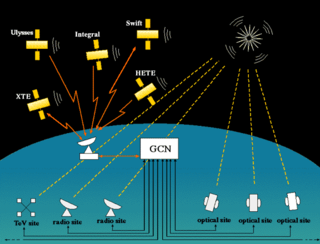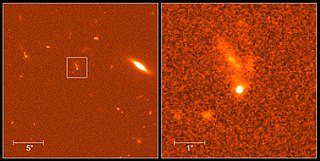
In gamma-ray astronomy, gamma-ray bursts (GRBs) are immensely energetic explosions that have been observed in distant galaxies. They are the most energetic and luminous electromagnetic events since the Big Bang. Bursts can last from ten milliseconds to several hours. After an initial flash of gamma rays, a longer-lived "afterglow" is usually emitted at longer wavelengths.

GRB 970228 was the first gamma-ray burst (GRB) for which an afterglow was observed. It was detected on 28 February 1997 at 02:58 UTC. Since 1993, physicists had predicted GRBs to be followed by a lower-energy afterglow, but until this event, GRBs had only been observed in highly luminous bursts of high-energy gamma rays ; this resulted in large positional uncertainties which left their nature very unclear.

The general coordinates network (GCN), formerly known as the gamma-ray burst coordinates network, is an open-source platform created by NASA to receive and transmit alerts about astronomical transient phenomena. This includes neutrino detections by observatories such as IceCube or Super-Kamiokande, gravitational wave events from the LIGO, Virgo and KAGRA interferometers, and gamma-ray bursts observed by Fermi, Swift or INTEGRAL. One of the main goals is to allow for follow-up observations of an event by other observatories, in hope to observe multi-messenger events.
The InterPlanetary Network (IPN) is a group of spacecraft equipped with gamma ray burst (GRB) detectors. By timing the arrival of a burst at several spacecraft, its precise location can be found. The precision for determining the direction of a GRB in the sky is improved by increasing the spacing of the detectors, and also by more accurate timing of the reception. Typical spacecraft baselines of about one AU and time resolutions of tens of milliseconds can determine a burst location within several arcminutes, allowing follow-up observations with other telescopes.

GRB 080319B was a gamma-ray burst (GRB) detected by the Swift satellite at 06:12 UTC on March 19, 2008. The burst set a new record for the farthest object that was observable with the naked eye: it had a peak visual apparent magnitude of 5.7 and remained visible to human eyes for approximately 30 seconds. The magnitude was brighter than 9.0 for approximately 60 seconds. If viewed from 1 AU away, it would have had a peak apparent magnitude of −67.57.

The Gamma-Ray Burst Optical/Near-Infrared Detector (GROND) is an imaging instrument used to investigate Gamma-Ray Burst afterglows and for doing follow-up observations on exoplanets using transit photometry. It is operated at the 2.2-metre MPG/ESO telescope at ESO's La Silla Observatory in the southern part of the Atacama desert, about 600 kilometres north of Santiago de Chile and at an altitude of 2,400 metres.

GRB 970508 was a gamma-ray burst (GRB) detected on May 8, 1997, at 21:42 UTC; it is historically important as the second GRB with a detected afterglow at other wavelengths, the first to have a direct redshift measurement of the afterglow, and the first to be detected at radio wavelengths.
The history of gamma-ray began with the serendipitous detection of a gamma-ray burst (GRB) on July 2, 1967, by the U.S. Vela satellites. After these satellites detected fifteen other GRBs, Ray Klebesadel of the Los Alamos National Laboratory published the first paper on the subject, Observations of Gamma-Ray Bursts of Cosmic Origin. As more and more research was done on these mysterious events, hundreds of models were developed in an attempt to explain their origins.

GRB 090423 was a gamma-ray burst (GRB) detected by the Swift Gamma-Ray Burst Mission on April 23, 2009 at 07:55:19 UTC whose afterglow was detected in the infrared and enabled astronomers to determine that its redshift is z = 8.2, which makes it one of the most distant objects detected to date with a spectroscopic redshift.

GRB 990123 is a gamma-ray burst which was detected on January 23, 1999. It was the first GRB for which a simultaneous optical flash was detected. Astronomers first managed to obtain a visible-light image of a GRB as it occurred on January 23, 1999, using the ROTSE-I telescope in Los Alamos, New Mexico. The ROTSE-I was operated by a team under Dr. Carl W. Akerlof of the University of Michigan and included members from Los Alamos National Laboratory and Lawrence Livermore National Laboratory. The robotic telescope was fully automated, responding to signals from NASA's BATSE instrument aboard the Compton Gamma Ray Observatory within seconds, without human intervention. In the dark hours of the morning of January 23, 1999, the Compton satellite recorded a gamma-ray burst that lasted for about a minute and a half. There was a peak of gamma and X-ray emission 25 seconds after the event was first detected, followed by a somewhat smaller peak 40 seconds after the beginning of the event. The emission then fizzled out in a series of small peaks over the next 50 seconds, and eight minutes after the event had faded to a hundredth of its maximum brightness. The burst was so strong that it ranked in the top 2% of all bursts detected.
GRB 050709 was a gamma-ray burst (GRB) detected on July 9, 2005. A gamma-ray burst is a highly luminous flash of gamma rays, the most energetic form of electromagnetic radiation, which is often followed by a longer-lived "afterglow" emitting at longer wavelengths.

GRB 991216, nicknamed the Beethoven Burst by Dr. Brad Schaefer of Yale University, was a gamma-ray burst observed on December 16, 1999, coinciding with the 229th anniversary of Ludwig van Beethoven's birth. A gamma-ray burst is a highly luminous flash associated with an explosion in a distant galaxy and producing gamma rays, the most energetic form of electromagnetic radiation, and often followed by a longer-lived "afterglow" emitted at longer wavelengths.
GRB 020813 was a gamma-ray burst (GRB) that was detected on 13 August 2002 at 02:44 UTC. A gamma-ray burst is a highly luminous flash associated with an explosion in a distant galaxy and producing gamma rays, the most energetic form of electromagnetic radiation, and often followed by a longer-lived "afterglow" emitted at longer wavelengths.
GRB 011211 was a gamma-ray burst (GRB) detected on December 11, 2001. A gamma-ray burst is a highly luminous flash associated with an explosion in a distant galaxy and producing gamma rays, the most energetic form of electromagnetic radiation, and often followed by a longer-lived "afterglow" emitted at longer wavelengths.
GRB 031203 was a gamma-ray burst (GRB) detected on December 3, 2003. A gamma-ray burst is a highly luminous flash associated with an explosion in a distant galaxy and producing gamma rays, the most energetic form of electromagnetic radiation, and often followed by a longer-lived "afterglow" emitted at longer wavelengths.
GRB 030329 was a gamma-ray burst (GRB) that was detected on 29 March 2003 at 11:37 UTC. A gamma-ray burst is a highly luminous flash associated with an explosion in a distant galaxy and producing gamma rays, the most energetic form of electromagnetic radiation, and often followed by a longer-lived "afterglow" emitted at longer wavelengths. GRB 030329 was the first burst whose afterglow definitively exhibited characteristics of a supernova, confirming the existence of a relationship between the two phenomena.
GRB 070714B was a gamma-ray burst (GRB) that was detected on 14 July 2007 at 04:59 UTC. A gamma-ray burst is a highly luminous flash associated with an explosion in a distant galaxy and producing gamma rays, the most energetic form of electromagnetic radiation, and often followed by a longer-lived "afterglow" emitted at longer wavelengths.

GRB 101225A, also known as the "Christmas burst", was a cosmic explosion first detected by NASA's Swift observatory on Christmas Day 2010. The gamma-ray emission lasted at least 28 minutes, which is unusually long. Follow-up observations of the burst's afterglow by the Hubble Space Telescope and ground-based observatories were unable to determine the object's distance using spectroscopic methods.

GRB 160625B was a bright gamma-ray burst (GRB) detected by NASA's Fermi Gamma-ray Space Telescope on 25 June 2016 and, three minutes later, by the Large Area Telescope. This was followed by a bright prompt optical flash, during which variable linear polarization was measured. This was the first time that these observations were made when the GRB was still bright and active. The source of the GRB was a possible black hole, within the Delphinus constellation, about 9 billion light-years away.










